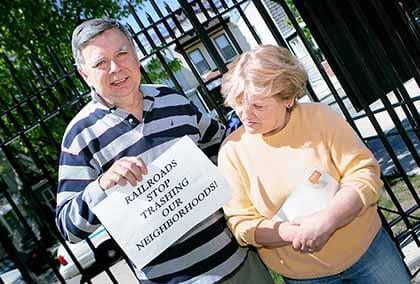By Joe Anuta
Two antiquated diesel trains that belch out clouds of pollution as they haul waste through Queens may get an environmentally friendly makeover if a federal grant is approved in the spring.
Several organizations partnered with the city and applied for a grant from the federal Environmental Protection Agency to outfit the two locomotives with more fuel-efficient engines that will reduce the emissions and pollution that are inhaled by Queens residents.
“We are just so thrilled, and it’s very gratifying that people have latched on to this idea of having a cleaner and greener neighborhood,” said Mary Parisen, co-chair of Civics United for Railroad Environmental Solutions, a collection of civic associations around the borough.
“This is a small step, but it’s in the right direction,” she said.
But the grants must still be approved by the EPA for its 2011 budget, and if actually selected in March, the outlays are scheduled to begin in May and be completed in October 2012.
“We’re really hoping that this grant does come through in March,” Parisen said.
The first grant would be used to refurbish a 1980s locomotive owned by CSX Transportation. The train now transports garbage from a station in the Bronx through Astoria, Jackson Heights, Woodside, Elmhurst, Maspeth, Middle Village and Ridgewood before terminating in Glendale.
The new engine will actually be comprised of three smaller engines, which will allow the locomotive to use them in stages and thus conserve fuel and curb emissions..
Nitrogen oxide, a pollutant released into the atmosphere by the locomotive, will be reduced by 20 tons annually, which is 76 percent. And particulate matter will be reduced by 0.21 tons.
The total grant will cost about $1.8 million, with $1 million coming from the EPA and the rest from CSX Transportation.
The second grant will be used to rebuild a 1973 New York & Atlantic Railway locomotive using a similar technique. That train carries waste from its Fresh Pond base in Glendale through Middle Village, Ridgewood, Maspeth, Blissville and Long Island City and also goes into Brooklyn.
The refurbished locomotive will cut fuel usage by 50 percent, and cut 1.1 tons of nitrogen oxide annually, but 20 tons over the project’s 18-year lifetime. It will reduce particulate matter by 0.44 tons.
The project will cost about $2.5 million, with $1 million coming from the EPA and a majority of the remaining funds from Waste Management Inc., the company employed by the city to move garbage into landfills.
The grant from the EPA is part of the agency’s National Clean Diesel Funding Assistance Program, which aims to make rail travel more green.
The project is especially pertinent for Queens, according to the grant, which said the borough has child asthma rates well above the national average.
That is exactly why CURES had been advocating for reform on how railroads operate in urban neighborhoods in the borough, according to Parisen, and they still have a long way to go. People in the Glendale neighborhood complain that the smell of diesel fuel and the pollution are so strong that they have trouble staying outside for extended periods of time.
But Parisen also recognizes it as a positive development.
“Don’t look a gift horse in the mouth,” Parisen said. “We’re grateful that it’s a start.”
And it is a start for the city as well.
“Repowering the entire NY&A locomotive fleet is the ultimate goal of the city of New York,” the grant said.
But the one NY&A locomotive that is included in the grant is only one of 10 total trains. The other nine are owned by the Long Island Rail Road and were not given permission for this particular upgrade.
The grants enjoyed the support of a gaggle of politicians, nonprofits and even Mayor Michael Bloomberg. It was written by the city Economic Development Corp.
Reach reporter Joe Anuta by e-mail at januta@cnglocal.com or by phone at 718-260-4566.



































